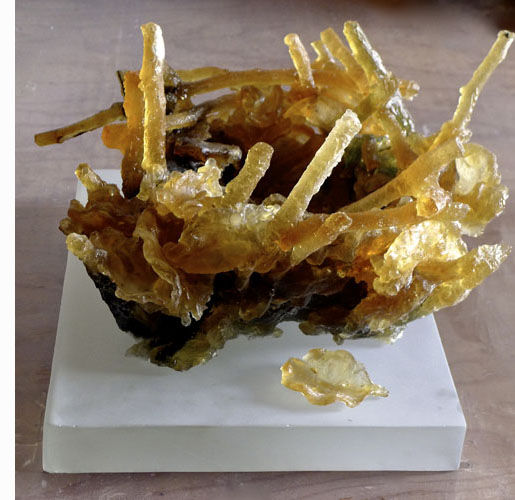.jpg) |
Portraying birds as bare-essence statues, would not, for most artists, be an intuitive choice for valorizing them. Rosen, who makes birds out of blown and cast glass, embraces the contradiction. She sculpts them as the Egyptians did, as inert icons, leaving just enough information in her attenuated shapes so that we can identify them as birds of prey: hawks, falcons, kestrels and kites. Hers are not portraits of individuals. They reveal only generic traits, most notably the poses of nobility that raptors strike when they perch on tree limbs or rocks. Frozen and statuary, but also heraldic in the manner of ancient gargoyles, they signal something far greater than just bird-ness.
That something is time – geologic time. It’s evoked by the alchemical process of glass making, which, in Rosen’s hands, involves chiseling, grinding and lacing of kiln-cooked organic materials with colored pigments. The birds and the pedestals they stand on look like weatherworn rock. In them we see the transparent glow of amber; intimations of various kinds of metamorphic rock (in particular schist, with its veins of quartz, mica and talc), along with marble, granite and sandstone. The resulting objects convincingly simulate actual rock. Wall-mounted birds, made from blown glass, are more reductive still, their black surfaces recalling Oaxaca pottery, beautiful but inscrutable, save for the heads, which appear alternately alert or sunken in quiet resignation.
.jpg) |
imprints. They reveal Rosen to be an acute observer of nature, one part Morris Graves, one part Robinson Jeffers, the Carmel poet who in Hawk and Rock immortalized in words what Rosen says in stone: “…Fierce consciousness joined with final/Disinterestedness/Life with calm death; the falcon's/ Realist eyes and act/Married to the massive…”
 |
Photographs of the artist’s studio reveal many such structures, indicating that in Rosen’s oeuvre, the man-nature divide, if it exists at all, is slender. This apparent confluence is embodied in her materials. The layers of the pedestal that support The Last Skyscraper, to take but one example, alternate between kiln-cast glass, marble and limestone. The limestone layer resembles concrete, a clear reference to the “built” environment alluded to by the title.
What a brilliant review. This writing is as beautiful and exquisite as the artwork. I have already seen this exhibit but now will go back to see it again with eyes newly opened by Mr. Roth.